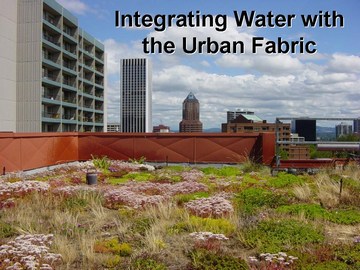Integrating Stormwater: The role of landscape architecture and site design in stormwater treatment
Integrated Design
In the January-February 2007 issue of Stormwater Magazine, writer Bill Tice describes how the City of Portland, Oregon, has become a leader in developing innovative methods to treat and manage rainwater/stormwater runoff through the integration of landscape architecture and site design.
The article quotes Bruce Ferguson, Franklin Professor of Landscape Architecture at the University of Georgia and director of the university’s School of Environmental Design. Ferguson says the City of Portland is doing a great job when it comes to integrating stormwater design into landscape architecture.
 “We have to end the idea that stormwater management facilities are expected to be utilitarian intrusions on the cities where they are located,” he says. “Cities are supposed to be for people, so we need to bring urban stormwater facilities in line with that purpose. Portland is the city everyone is talking about, and they are doing a great job when it comes to integrating stormwater systems with landscape architecture.”
“We have to end the idea that stormwater management facilities are expected to be utilitarian intrusions on the cities where they are located,” he says. “Cities are supposed to be for people, so we need to bring urban stormwater facilities in line with that purpose. Portland is the city everyone is talking about, and they are doing a great job when it comes to integrating stormwater systems with landscape architecture.”
To read the complete story in Stormwater Magazine, click on Stormwater: The role of landscape architecture and site design in stormwater treatment.
Acknowledgement:
Before STORMWATER, The Journal for Surface Water Quality Professionals, there was no single publication written specifically for the professional involved with surface water quality issues, protection, projects, and programs.
City of Portland Coins RAIN Acronym
At the Water in the City Conference held in Victoria, British Columbia in September 2006, Tom Liptan of Portland, Oregon informed his Canadian audience that the City Portland has coined the acronym RAIN to contrast contemporary ‘rainwater management’ with traditional ‘stormwater management’, where:
-
RAIN = Retaining and Integrating Nature
A landscape architect with the Bureau of Environmental Services, Tom Liptan has been the driving force behind the research and development of new urban techniques, codes and policies in the City of Portland.
 When he began his 90-minute presentation, Tom Liptan commented that “It is great to see that the Province of British Columbia is proactively encouraging the drainage community to start using the all-encompassing Rainwater Management as an alternative to single-objective Stormwater Management.”
When he began his 90-minute presentation, Tom Liptan commented that “It is great to see that the Province of British Columbia is proactively encouraging the drainage community to start using the all-encompassing Rainwater Management as an alternative to single-objective Stormwater Management.”
“The language-shift that you have initiated in British Columbia is what we would like to see happen in Portland. This is one reason why the Bureau of Environmental Services has coined the RAIN acronym. We believe this will help promote changes in thinking and practice so that we achieve beneficial outcomes.”
“Traditional stormwater management has a narrow scope, is event-based, and only considers a handful of runoff events that might occur in a given year. Rainwater management, on other hand, accounts for all the rainfall-days that occur each year.”
“Rainwater management is all about developing in a way that restores the function and value of trees, soil and open space in our communities. If we develop today with long-term sustainability in mind, future generations can enjoy a vibrant city and clean and healthy rivers, instead of bearing the burden of our actions”, concluded Liptan.


